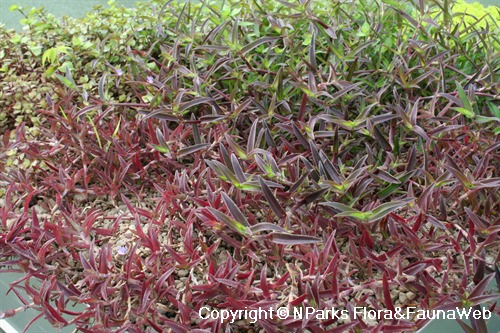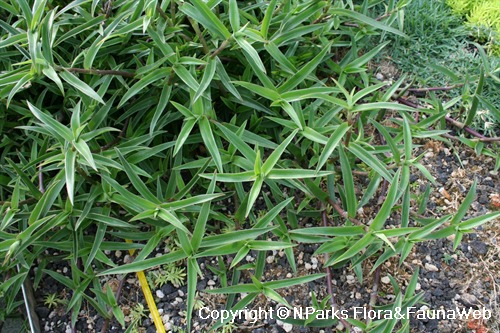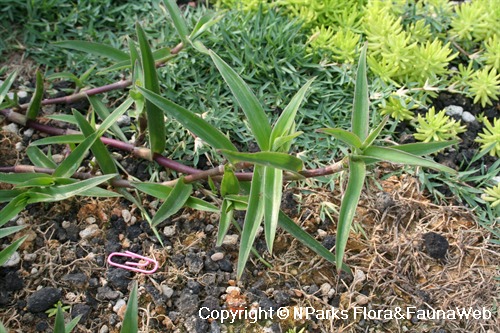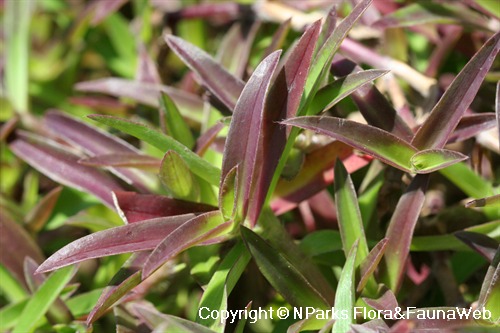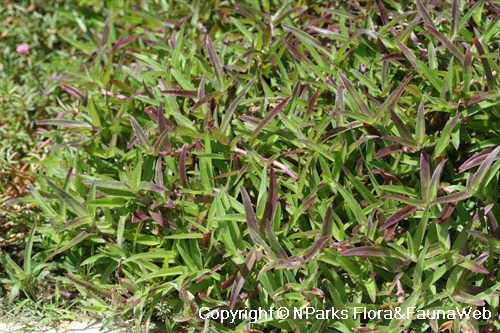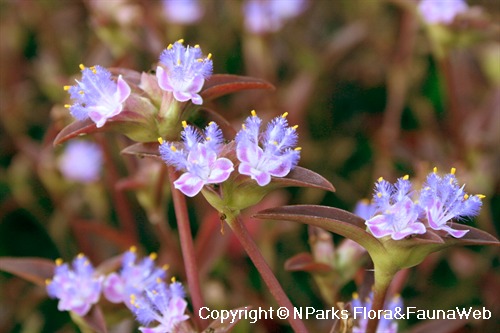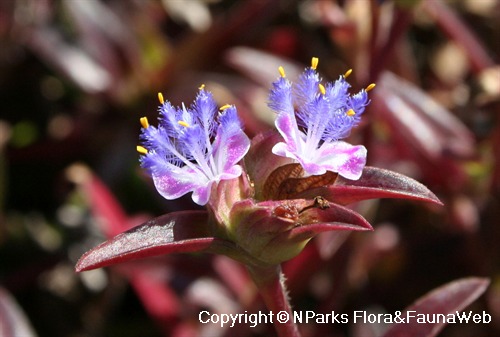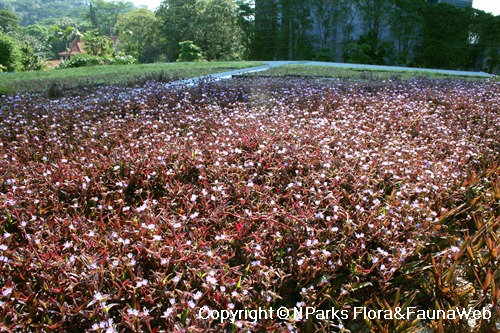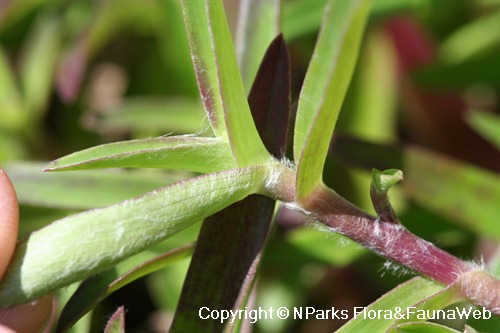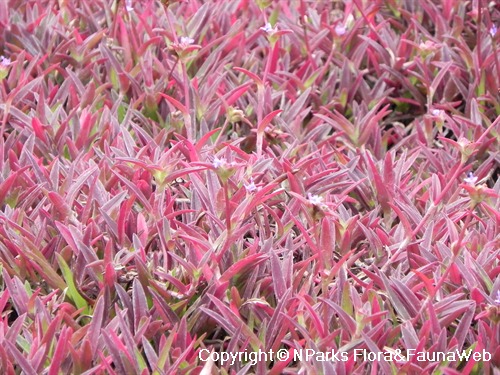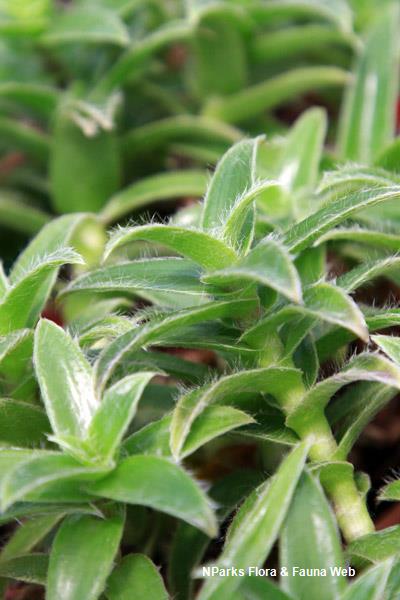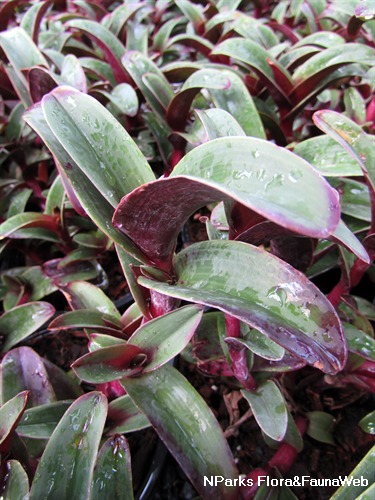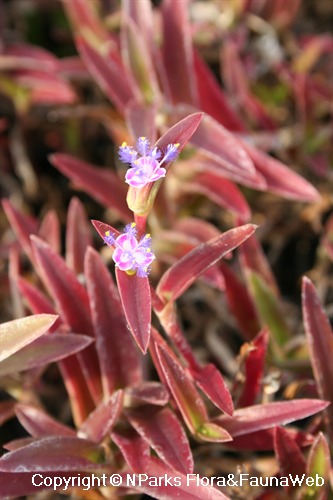
Back
Cyanotis cristata D.Don
| Family Name: | Commelinaceae |
| Synonyms: | Tradescantia cristata (L.) L., Cyanotis imbricata (Roxb.) Kunth, Commelina cristata L. |
| Common Name: | Crested Dew-Grass, Nabhali, Netha Kina, 四孔草 |
Name
Classifications and Characteristics
| Plant Division | Angiosperms (Flowering Seed Plants) (Monocotyledon) |
|---|---|
| Plant Growth Form | Creeper |
| Lifespan (in Singapore) | Perennial |
| Mode of Nutrition | Autotrophic |
| Maximum Height | 0.3 m |
| Maximum Plant Spread / Crown Width | 0.1 m to 0.5 m |
Biogeography
| Native Distribution | Northeast Tropical Africa (Ethiopia), Pakistan, India, Sri Lanka, Maldives, Mauritius, Bangladesh, Himalayas, Southern China, Myanmar, Laos, Vietnam, Cambodia, Peninsular Malaysia, Java, Philippines |
|---|---|
| Native Habitat | Terrestrial (Grassland / Savannah/ Scrubland), Shoreline (Sandy Beach) |
| Preferred Climate Zone | Tropical, Sub-Tropical / Monsoonal |
| Local Conservation Status | Cryptogenic |
Description and Ethnobotany
| Growth Form | Herbaceous succulent shrub, forms thick mounded mats of up to around 30cm height. |
|---|---|
| Foliage | Leaves fleshy, hairy along margins, turns from green to reddish when exposed to strong sun and drought stress. |
| Stems | Fleshy, prostrate and creeping, branching at irregular intervals. |
| Flowers | Small, purplish-white petals with attractive purple-blue filamentous styles topped by yellow anthers, produced in few-flowered terminal inflorescences; free-flowering. |
| Fruit | Brown explosive capsules with tiny seeds and persistent bracts. |
| Others - Plant Morphology | Local Conservation Status: Previously considered as native to Singapore by various local references (eg. Hsuan Keng 1998, etc.) Listed as an exotic weed of uncertain origin by recent research (A Checklist of the Total Vascular Plant Flora of Singapore, NUS-RMBR, Nov 09). |
| Habitat | It can be found in grassy spots and sandy areas near the sea. |
| Cultivation | Very drought-tolerant, able to withstand at least 2 weeks without rain or watering. Spreads very quickly and may overtake nearby plants to form monoculture plot, prune to control aggressive growth. Propagate by stem cuttings. |
| Etymology | Genus epithet 'Cyanotis' means 'blue' in Greek (kyanos), a reference to the colour of the flowers. Species epithet 'cristata' means 'having tassel-like tips' or 'crested', which describes the hairy styles of the flowers. |
| Ethnobotanical Uses | Food (Herb or Spice) Others: Roots used to treat swelling and snakebite. |
Landscaping Features
| Desirable Plant Features | Ornamental Flowers, Ornamental Foliage |
|---|---|
| Landscape Uses | Coastal Plant, Skyrise / Balcony, Suitable for Rooftops, Vertical Greenery / Green Wall, Flowerbed / Border, Suitable for Hanging Baskets |
| Thematic Landscaping | Rockery / Desert Garden |
Fauna, Pollination and Dispersal
| Seed or Spore Dispersal | Abiotic (Explosive Dehiscence) |
|---|
Plant Care and Propagation
| Light Preference | Full Sun |
|---|---|
| Water Preference | Moderate Water, Little Water |
| Plant Growth Rate | Fast |
| Rootzone Tolerance | Well-Drained Soils, Poor Infertile Soils, Saline Soils / Salt Spray, Shallow Media, Disease / Pest Resistant, Drought Tolerant |
| Potential Problems | Spreads very quickly. Often overwhelms nearby plants. |
| Propagation Method | Seed, Stem Cutting |
| Maintenance Requirements Remarks | Prune plant to contain growth. |
Foliar
| Foliage Retention | Evergreen |
|---|---|
| Mature Foliage Colour(s) | Green, Red |
| Mature Foliage Texture(s) | Smooth, Hairy / Hirsute, Thick |
| Foliar Type | Simple / Unifoliate |
| Foliar Arrangement Along Stem | Alternate |
| Foliar Shape(s) | Non-Palm Foliage (Ovate, Lanceolate, Oblong) |
| Foliar Margin | Entire |
| Foliar Base | Cordate |
| Typical Foliar Area | Microphyll ( 2.25cm2 - 20.25 cm2 ) |
| Leaf Area Index (LAI) for Green Plot Ratio | 3.5 (Shrub & Groundcover - Monocot) |
Non - Foliar and Storage
| Stem Type & Modification | Herbaceous |
|---|---|
| Root Type | Underground (Fibrous Root) |
| Specialised Storage Organ(s) | Aboveground |
Floral (Angiosperm)
| Flower & Plant Sexuality | Bisexual Flowers |
| Flower Colour(s) | Blue, Purple |
|---|---|
| Flowering Period | Free-Flowering |
| Flowering Opening Time | Time-Independent |
| Flowering Habit | Polycarpic |
Fruit, Seed and Spore
| Fruit Classification | Simple Fruit |
|---|---|
| Fruit Type | Dehiscent Dry Fruit , Capsule |
Image Repository
Others
| Master ID | 616 |
|---|---|
| Species ID | 1911 |
| Flora Disclaimer | The information in this website has been compiled from reliable sources, such as reference works on medicinal plants. It is not a substitute for medical advice or treatment and NParks does not purport to provide any medical advice. Readers should always consult his/her physician before using or consuming a plant for medicinal purposes. |

